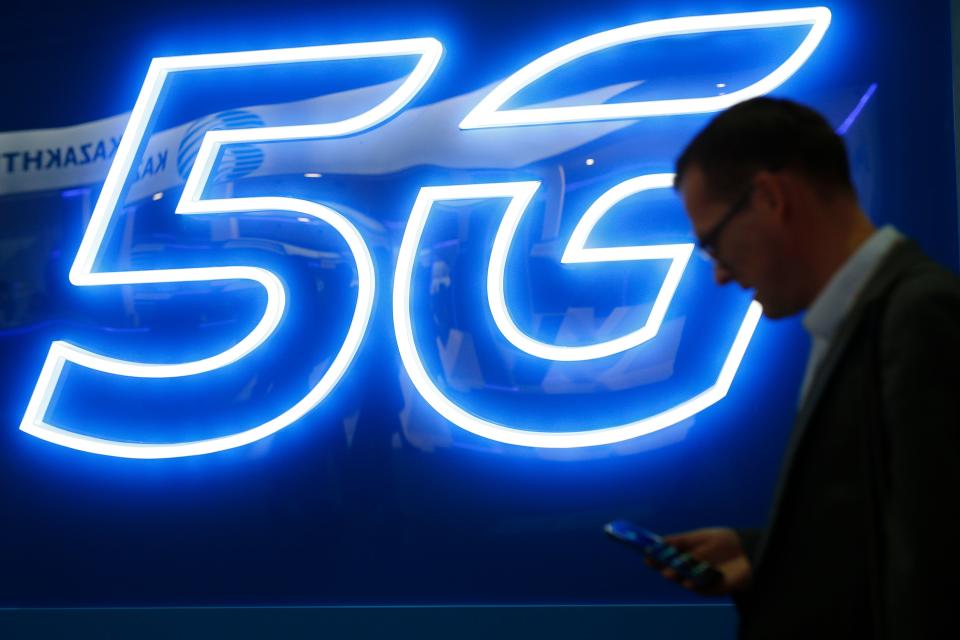No, you don’t need a 5G phone yet

BARCELONA—Smartphone vendors have introduced an impressive lineup of 5G smartphones at the MWC trade show here. And you should be happy to let your most tech-addicted neighbor buy one first.
That’s not because 5G wireless broadband and its promised benefits of faster speeds and lower latency—both magnitudes better than 4G LTE—offer no value to smartphone users. It’s because the first round of phones will cost too much and involve too many trade-offs. And, waiting another year or so should let the industry grind away at those obstacles.
The contenders
The two 5G phones announced in the U.S. market—LG’s V50 ThinQ and Samsung’s Galaxy S10 5G, both confirmed for Sprint (S) and Yahoo Finance corporate parent Verizon (VZ), with the latter also coming to AT&T (T)—share some key traits.
One is their lack of announced prices. A second is large sizes—The S10 5G gets a 6.7-inch screen, while the V50 features a 6.2-inch display. Then there are such high-end features as multiple-camera arrays on the back of each of these Android devices that suggest they’ll exceed the $999 cost of Samsung's S10 Plus.
That’s a predictable reality in a device that debuts a new feature.
“From a value proposition of 5G, any time someone comes up with a new device with a new feature, they might want to extract higher value from it,” Peter Lancia, marketing vice president at Qualcomm (QCOM), said in an interview last week.
How much higher value? One hint can come from the steep prices already revealed for such foldable phones as Samsung’s $1,980 Galaxy Fold and Huawei’s 5G Mate X, which is priced at roughly $2,600, but is almost certainly not coming to the U.S. market. Manufacturers know that they can charge a premium to people who will leap at the next shiny object.
“The people that are going to jump on 5G are not that dissimilar from the foldable people,” said Creative Strategies analyst Carolina Milanesi. “They are early-tech customers.”
Qualcomm inside
Both Samsung and LG’s 5G phones also use Qualcomm’s first-generation X50 5G modem, which supports only a subset of the 5G frequencies that U.S. carriers will employ.
You’ll have to wait for Qualcomm’s next 5G modem, the X55, to get phones that support the full range of 5G frequencies beyond the early allotment of fast but short-range millimeter-wave and some lower-frequency brands. AT&T noted that with a line in its own announcement that touted an upcoming Samsung smartphone that will connect to 5G beyond AT&T’s mm-wave based 5G service.
The X50’s limits also explain why T-Mobile (TMUS) has had to clarify its pledges to sell 5G service in the first half of this year. The longer-range 5G service the carrier has emphasized in its earlier statements won’t see support in phones until the second half of 2019, leaving buyers of first-half phones limited to mm-wave service.
Initial 5G deployments will also limit how often you can enjoy that next-gen connectivity. Coverage maps shared by Sprint here Monday—the first such documentation by a carrier—show patchy early coverage in its first round of cities, as little as 20 square miles in Chicago.
Buyers of these early models will need to keep those distinctions in mind.
"We believe that the 5G consumer is going to be a lead tech-adopter consumer, is going to be extremely well-versed in what the technology is for each carrier, and will understand fairly well what the experience will be," said Justin Denison, Samsung’s senior vice president for phone product marketing.
Another reason to look forward to 2020
One of the worst fears of 5G phones—that their power consumption would demand mid-day recharging—may not come to pass. Qualcomm and manufacturers say they will avoid repeating the horrific battery life of the first crop of 4G LTE phones with power-saving techniques and bigger batteries.
But by this time next year, we should see phones based on yet another upcoming chipset from Qualcomm: a “system on a chip” module that, like today’s LTE circuitry, combines both processing and connectivity in a single module that manufacturers can build a phone around.
“Qualcomm's 5G SOC is important as it will make 5G mainstream and available not just for premium phones but mid-range ones, too,” wrote Patrick Moorhead, president of Moor Insights & Strategy, in a Twitter (TWTR) direct message. “SOCs use less energy and are smaller than discrete components meaning these solutions will be less expensive, use smaller batteries and have longer battery life.”
In the meantime, you don’t lose that much by waiting beyond bragging rights that nobody will remember in two years. We may be on the fifth major chapter of wireless connectivity, but it’s still a questionable practice to buy the first version of anything.
Correction: T-Mobile will sell 5G service in the first half of this year, but phones supporting the longer-range 5G frequencies won't arrive until the second half of the year. The article has been updated to reflect that fact.
More from Rob:
Email Rob at rob@robpegoraro.com; follow him on Twitter at @robpegoraro.

 Yahoo Finance
Yahoo Finance 

